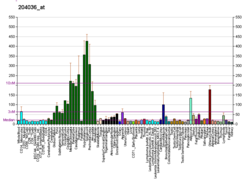Lysophosphatidic acid receptor 1 also known as LPA1 is a protein that in humans is encoded by the LPAR1 gene.[4][5][6] LPA1 is a G protein-coupled receptor that binds the lipid signaling molecule lysophosphatidic acid (LPA).[7]
- ^ a b c GRCm38: Ensembl release 89: ENSMUSG00000038668 – Ensembl, May 2017
- ^ "Human PubMed Reference:". National Center for Biotechnology Information, U.S. National Library of Medicine.
- ^ "Mouse PubMed Reference:". National Center for Biotechnology Information, U.S. National Library of Medicine.
- ^ "Entrez Gene: LPAR1 Lysophosphatidic acid receptor 1".
- ^ Hecht JH, Weiner JA, Post SR, Chun J (November 1996). "Ventricular zone gene-1 (vzg-1) encodes a lysophosphatidic acid receptor expressed in neurogenic regions of the developing cerebral cortex". J. Cell Biol. 135 (4): 1071–83. doi:10.1083/jcb.135.4.1071. PMC 2133395. PMID 8922387.
- ^ An S, Dickens MA, Bleu T, Hallmark OG, Goetzl EJ (February 1997). "Molecular cloning of the human Edg2 protein and its identification as a functional cellular receptor for lysophosphatidic acid". Biochem. Biophys. Res. Commun. 231 (3): 619–22. doi:10.1006/bbrc.1997.6150. PMID 9070858.
- ^ Choi JW, Herr DR, Noguchi K, Yung YC, Lee CW, Mutoh T, Lin ME, Teo ST, Park KE, Mosley AN, Chun J (January 2010). "LPA Receptors: Subtypes and Biological Actions". Annual Review of Pharmacology and Toxicology. 50 (1): 157–186. doi:10.1146/annurev.pharmtox.010909.105753. PMID 20055701.




